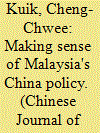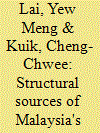|
|
|
Sort Order |
|
|
|
Items / Page
|
|
|
|
|
|
|
| Srl | Item |
| 1 |
ID:
177634


|
|
|
| 2 |
ID:
145881


|
|
|
|
|
| Summary/Abstract |
The extant literature on alignment behavior has focused primarily on the macro dimensions, i.e. the typology, manifestations and implications of states’ alignment choices vis-à-vis the great power(s). Relatively few studies have examined the micro aspects of alignment choices. This article attempts to fill in the gap by unpacking the constituent component of weaker states’ alignment decisions, with a focus on ASEAN states’ hedging behavior in the face of a rising China in the post-Cold War era. It contends that the enduring uncertainty at the systemic level has compelled the states to hedge by pursuing contradictory, mutually counteracting transactions of ‘returns-maximizing’ and ‘risk-contingency’ options, which seek to offset the potential drawbacks of one another, as a way to project a non-taking-sides stance while keeping their own fallback position at a time when the prospect of power structure is far from clear.
|
|
|
|
|
|
|
|
|
|
|
|
|
|
|
|
| 3 |
ID:
182622


|
|
|
|
|
| Summary/Abstract |
Laos is among the Southeast Asian countries that had engaged China on infrastructure cooperation well before the Belt and Road Initiative (BRI) was launched in 2013. Subsequently, Laos has embraced the BRI openly and receptively. Laos's most expensive and controversial project, the Vientiane-Boten railway, is China's signature BRI venture in Laos. The country's BRI engagement also includes special economic zones and unequal partnerships in hydropower, mining, and agricultural projects. To elucidate why Laos embraces the BRI despite the controversies and concerns surrounding the Beijing-backed projects, this essay uses an asymmetry-authority framework to argue that, while power asymmetry entails apprehensions, the Lao ruling elites' political needs to preserve and advance their authority led them to downplay anxieties and instead highlight the benefits of the China-financed projects. The rail venture, in particular, aims to transform Laos from a landlocked country to a "land-linked" one, which will extend connectivity, increase trade, and attract investment, thus enhancing and legitimizing the elites' rule.
|
|
|
|
|
|
|
|
|
|
|
|
|
|
|
|
| 4 |
ID:
126587


|
|
|
|
|
| Publication |
2013.
|
| Summary/Abstract |
Using Malaysia's China policy as a case study of a smaller state's response to a rising power, this article challenges the mainstream neorealist notion that the growing capability and geographical proximity of a rising power tend to induce fear among its weaker neighbours. By tracing the transformation of Malaysia's China policy, the article's findings indicate that power asymmetry and geographical proximity have no inherent logic of their own; rather, whether and to what extent the two variables will prompt smaller states to become fearful and/or attracted to a rising power is often a function of intervening factors at the domestic level, i.e. the imperative of ruling elite's domestic legitimation. In the case of Malaysia's China policy, it is the ruling Barisan Nasional elite's desire to capitalize on the big power's rise-for the ultimate goal of enhancing and justifying its political authority at home-that has driven the smaller state to adopt a hedging approach characterized by an inclination to prioritize immediate economic and diplomatic benefits over potential security concerns, while simultaneously attempting to keep its strategic options open for as long as the systemic conditions allow.
|
|
|
|
|
|
|
|
|
|
|
|
|
|
|
|
| 5 |
ID:
187450


|
|
|
|
|
| Summary/Abstract |
This paper adopts a two-level model to explain Malaysia’s forward diplomacy toward the Northeast Asian states, the larger economies beyond its immediate neighborhood of Southeast Asia. We contend that while such structural conditions as power dynamics drive and constrain the smaller state’s agency toward the Northeast Asian nations, their effects are filtered by domestic politics, specifically the ruling elite’s pathways of legitimation. The findings highlight that while diplomacy is almost always motivated by the imperatives of immediate reality and identity, there is a different genre of driver, that of nurtured necessity. This paper illustrates how Malaysia’s outlook toward the Northeast Asian states—and its resulting active and anticipatory diplomacy—has been more “discovered” than determined and why such diplomacy has been driven more by the elite’s domestic political needs than the idiosyncrasies of its leaders.
|
|
|
|
|
|
|
|
|
|
|
|
|
|
|
|
| 6 |
ID:
177641


|
|
|
| 7 |
ID:
191740


|
|
|
|
|
| Summary/Abstract |
Why do weaker states perceive the liberal international order (LIO) with ambivalence? This article argues that in the case of small states like Malaysia, historical memories, structural realities and domestic imperatives combine to explain their conceptions of and responses to the LIO. The article traces the features and unpacks the factors underpinning the paradoxes of small-state pragmatism vis-à-vis international order: a) rejecting power hierarchy but recognizing (and leveraging) power asymmetry; b) acknowledging its smallness but actively punching above its weight whenever possible; and c) promoting co-existence through principled contradictions. Such paradoxical pragmatism is quintessentially an act of hedging aimed at mitigating and off-setting multiple risks amid increasing uncertainties. This article makes three contributions. First, it contributes to the literature on international order by presenting a small-state perspective on the LIO, highlighting that small-state responses are more about ‘struggle for survival’, rather than ‘struggle for power’. Second, the notion of ‘paradoxical pragmatism’ engages the ongoing debate on ‘hedging’ in international relations. Third, the article's findings suggest that, theoretically, hedging and its dualistic elements are attributable to both structural and domestic-level factors. While structural conditions drive states to hedge, domestic factors determine the extent and manner in which states hedge.
|
|
|
|
|
|
|
|
|
|
|
|
|
|
|
|
| 8 |
ID:
124872


|
|
|
|
|
| Publication |
2013.
|
| Summary/Abstract |
This article explains Malaysia's US policy under Prime Minister Najib. It argues that to the extent that there is a "shift" in Malaysia's policy, its substance has been shaped by structural and domestic considerations. Structurally, in the face of a fast rising China, Malaysia is compelled to keep a more balanced relationship with all the major powers. This structural push, reinforced by Obama's "pivot," has been nonetheless limited by a concern about the risks of entrapment, abandonment, and antagonism. Domestically, there are economic and political motivations to develop closer ties with Washington. These, however, have been counteracted by a calculation of not wanting to align too closely with America. These structural and domestic determinants together explain the smaller state's strategy towards the superpower at a time of systemic change.
|
|
|
|
|
|
|
|
|
|
|
|
|
|
|
|
| 9 |
ID:
192166


|
|
|
|
|
| Summary/Abstract |
This essay unpacks the hedging behavior of small and secondary states by focusing on Southeast Asian responses to the intense US-China rivalry and the emergence of the Quadrilateral Security Dialogue (Quad) in the Indo-Pacific region. It contends that the weaker states’ perceptions of external realities are not black and white, but shades of grey, as uncertainty breeds ambiguity and ambivalence. The states often do not view a major power (and its initiatives) as either a clear-cut threat or a straightforward solution. Instead, they perceive a spectrum of risks and challenges, each with constantly changing manifestations and magnitude, all of which require complex combinations of mutually-reinforcing and counteracting measures. All ASEAN states have mixed attitudes towards the competing powers, viewing both the Quad’s Free and Open Indo-Pacific (FOIP) strategies and China’s Belt and Road Initiative (BRI) as bringing not only opportunities but also risks and dangers. These ambivalent perceptions entail a process of ‘riskification’, where states identify and prioritize certain risks while downplaying others, in ways that serve elite interests at home. Hence, while nearly all the ASEAN states have stressed in varying degrees the risks of entrapment, abandonment, polarization and marginalization, many have downplayed the dangers of big-power aggressiveness and interference, some more so than others. The varying riskification patterns thus lead to varying hedging acts, prompting subtly different responses to the emerging realities.
|
|
|
|
|
|
|
|
|
|
|
|
|
|
|
|
| 10 |
ID:
178855


|
|
|
|
|
| Summary/Abstract |
This essay traces the structural sources of Malaysia's South China Sea policy. It argues that Malaysia's ‘light-hedging’ approach is primarily a smaller-state's response to growing systemic pressure arising from power asymmetry, rivalry, and uncertainties. The features of this approach are: an insistence on not taking sides, concurrent adoption of open deference and indirect defiance, and an active effort to cultivate a fallback position, all aimed at reducing multiple risks associated with the uncertainties of US commitment , China's long-term intentions, and their future relations. We have arrived at three main findings. First, structural impact matters: as geopolitical uncertainty increases, weaker states hedge more deeply. Second, smaller states do have agency, even if only in a low-profile manner. Because smaller states have been disadvantaged under an asymmetric power structure, they often use a combination of diplomatic, legal, developmental, and defence means to shape favourable external conditions. Third, while hedging is chiefly a result of structural factors, the forms and degree of a state's hedging activism are necessarily a function of its threat perceptions, elite interests and other unit-level variables. These factors explain Malaysia's light form of hedging: quiet action and limited defiance alongside open accommodation in managing the South China Sea disputes.
|
|
|
|
|
|
|
|
|
|
|
|
|
|
|
|
| 11 |
ID:
177652


|
|
|
|
|
| Summary/Abstract |
This essay offers a small state perspective on US-China rivalry
in the post-COVID-19 era. After tracing the emergence of
the “twin chessboards” of big power rivalry, namely, high
and low politics competitions, the essay assesses the impact
of these competitions on the post-pandemic Asian order,
with a focus on Southeast Asia. I argue that while US-China competition has been rising rapidly in high politics (that
is, in the military field), the increasing importance of low
politics—infrastructure and connectivity development, technology, trade, finance, public health, and other functional
areas—is shaping the prospects, pace, and patterns of the
onset of Cold War 2.0. The intensified US-China animosity
across the twin chessboards is widening the scope of the
competition, increasing the number of players, and mounting pressure on all smaller states. Arguably, however, it is
also providing these smaller states with more maneuvering
space. These developments reshape geostrategic supply and
demand in Southeast Asia. Accordingly, the smaller states
are developing additional layers of partnerships with actors
near and far, thereby broadening their hedging options in
an increasingly uncertain and high-stake environment.
|
|
|
|
|
|
|
|
|
|
|
|
|
|
|
|
|
|
|
|
|